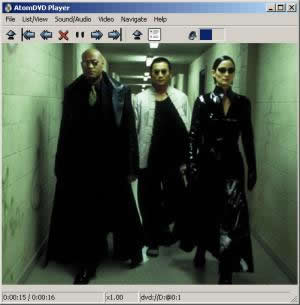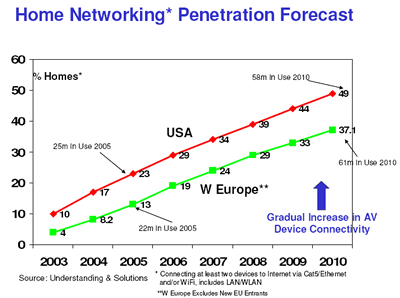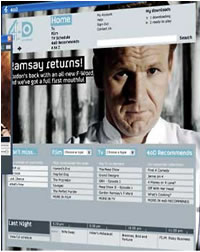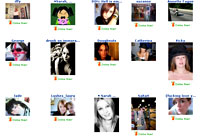 Marty Lafferty, CEO of the Distributed Computing Industry Association (DCIA) concludes his synopsis of the Next Generation P2P sessions at the recent Digital Hollywood Europe conference held in London’s docklands.
Marty Lafferty, CEO of the Distributed Computing Industry Association (DCIA) concludes his synopsis of the Next Generation P2P sessions at the recent Digital Hollywood Europe conference held in London’s docklands.
Guido Ciburski (pictured right) announced that CyberSky-TV’s streaming video P2P software was declared legal in Germany two months ago, after protracted court proceedings, and that now the questions are how to put it to best commercial use and how to advertise it so that it stays that way. He said the attractiveness of the software is its higher quality online video experience, which takes advantage of higher upload speeds available to broadband users. The US Supreme court decision has been misinterpreted by many, but in the final analysis has not changed much in terms of consumer behavior. P2P usage has continued its steady expansion, notwithstanding market share shifts among applications, basically regardless of related cases and settlements.
Major record labels and movie studios need to take time at this point in their migration to a digital distribution marketplace to listen more to consumers. There has been too little feedback from users factored into digital distribution strategies. There needs to be more interaction with the community of P2P users, and an effort to maximize the satisfaction of consumers with new business models. Going forward, the increase in broadband penetration will drive more growth of P2P, and local storage capabilities and content consumption patterns will change as a function of more speed and capacity.
Dr. Nimrod Koslowski articulated a new vision by stating that content being redistributed via P2P networks can be both controlled and accelerated. Oversi’s patent-pending caching system enables ISPs to monetize P2P and deal with network imbalances arising from the widespread adoption of P2P. It should indeed be experimentation time in this channel. Major content companies can participate at very little risk by putting some of their deeply archived, least monetized, long-tail content into P2P trials. Let material that is not the highest value content travel freely and find new ways to monetize it. There are many new interactive advertising and value-adding layers and payment mechanisms. Experiment and then scale what works.
The Grokster decision should be a clear green light that P2P is legal; inducement to infringe copyright is not. Going after end-users for enforcement purposes is a failed proposition, however. Encouraging content to be redistributed with new forms of monetization will be the winner. We need to get away from proprietary formats and embrace P2P in intuitive ways and couple it with operating systems. The industry needs to relate to the way content actually is being redistributed in terms of developmental priorities and not fight it. Don’t block applications. P2P will become much more integrated into the online environment in the future; not just files, but also acceptable levels of security integrated into our digital-social fabric.
Bruce Benson concluded with his observation that the entertainment industry is indeed evolving to digital distribution – and that such iconoclastic developments as music companies learning to market MP3s rather than DRM’d content may be coming, as well as movie companies adopting new approaches to market their entire libraries online despite legacy sequential-distribution windows. What’s working in P2P is free content. What’s not working is paid content. We need to take a lesson from the video/DVD market, which learned that it could more than makeup with high volume lower-unit-cost transactions (rentals) what it lost from relying exclusively on sales.
 FTI Consulting believes it could generate sixty cents per view in ad-supported P2P movies for example. There is the opportunity to put whole libraries to work in this channel. The problems are rights complications, executive bandwidth, etc. – business issues rather than technology issues. Copyright laws are outdated and the US Congress writing tuck ‘n fixes for what has become too complex is no longer going to be effective – copyright laws can’t deal with mash-ups for instance. Rights holders should digitize everything and clear the rights to be able to monetize their works as new P2P models become clarified. We will see the completion of a cable by-pass online, and content elasticity will continue to expand as YouTube has so aptly demonstrated.
FTI Consulting believes it could generate sixty cents per view in ad-supported P2P movies for example. There is the opportunity to put whole libraries to work in this channel. The problems are rights complications, executive bandwidth, etc. – business issues rather than technology issues. Copyright laws are outdated and the US Congress writing tuck ‘n fixes for what has become too complex is no longer going to be effective – copyright laws can’t deal with mash-ups for instance. Rights holders should digitize everything and clear the rights to be able to monetize their works as new P2P models become clarified. We will see the completion of a cable by-pass online, and content elasticity will continue to expand as YouTube has so aptly demonstrated.
Audience questions ranged from how to get tech savvy kids to pay for content to how to convince ISPs that P2P can provide desired quality of service (QoS) levels. Answers confirmed that people will pay for convenience, value, and reliability; and enhanced hybrid P2P systems can do this better than alternatives.
All affected parties need to participate actively in developing a new commerce engine, which is different from just putting up toll-booths. It’s time for more resources to be directed towards creators and innovators. This is a uniquely open environment with the lowest barrier to entry of any channel and enormous possibilities. Share wisely, and take care.
Part one of the coverage – Next Generation P2P: Digital Hollywood Europe.
Part two of the coverage – Next Generation P2P – Digital Hollywood Europe.
Reproduced with permission of the DCIA. For more information, plan to attend the day-long P2P MEDIA SUMMIT NY on February 6, 2007.
 We like PURE, they create innovative products DAB radio – and they
We like PURE, they create innovative products DAB radio – and they Given that they’ve given the chance, we just as well tell you that, there’s a whole range available …there and waiting for you to take them to their 2 millionth …
Given that they’ve given the chance, we just as well tell you that, there’s a whole range available …there and waiting for you to take them to their 2 millionth … Marty Lafferty, CEO of the Distributed Computing Industry Association (DCIA) gives us a synopsis of the Next Generation P2P sessions at the recent
Marty Lafferty, CEO of the Distributed Computing Industry Association (DCIA) gives us a synopsis of the Next Generation P2P sessions at the recent  Daniel Harris (pictured right) provided Kendra’s perspective on P2P from its alliance of content owners and software makers. Daniel’s vision is that any application on any device should be able to browse any catalog, and there should be universal interoperability. Record labels have had different ways of managing their catalogs, historically; now we need to show them that with P2P it is possible to aggregate databases and achieve across-the-board content monetization. P2P can bring benefits of non-centralized search and publishing to all sorts of content databases.
Daniel Harris (pictured right) provided Kendra’s perspective on P2P from its alliance of content owners and software makers. Daniel’s vision is that any application on any device should be able to browse any catalog, and there should be universal interoperability. Record labels have had different ways of managing their catalogs, historically; now we need to show them that with P2P it is possible to aggregate databases and achieve across-the-board content monetization. P2P can bring benefits of non-centralized search and publishing to all sorts of content databases. More than 1 in 3 European households will have an integrated home network by 2010, according to a new industry report from Understanding & Solutions.
More than 1 in 3 European households will have an integrated home network by 2010, according to a new industry report from Understanding & Solutions.
 UK Independent broadcaster Channel 4 will today at 12:00 launch their PC-based Video on Demand (VoD) service, 4OD (pronounced four Oh Dee). They claim they’re the first major broadcaster in the World to do it.
UK Independent broadcaster Channel 4 will today at 12:00 launch their PC-based Video on Demand (VoD) service, 4OD (pronounced four Oh Dee). They claim they’re the first major broadcaster in the World to do it. Initially the programmes will be delivered ad-free, but Channel 4 tell us that they may well be introducing advert-supported downloaded content in April.
Initially the programmes will be delivered ad-free, but Channel 4 tell us that they may well be introducing advert-supported downloaded content in April. MySpace has announced that they will be scanning the user accounts on the service, deleting those of registered sex offenders.
MySpace has announced that they will be scanning the user accounts on the service, deleting those of registered sex offenders. MySpace has had to juggle with the fear of parents that their children are making themselves targets for unwelcome attention from those wishing to do harm to them.
MySpace has had to juggle with the fear of parents that their children are making themselves targets for unwelcome attention from those wishing to do harm to them. Marty Lafferty, (pictured right) CEO of the Distributed Computing Industry Association (DCIA) gives us a synopsis of the Next Generation P2P sessions at the recent
Marty Lafferty, (pictured right) CEO of the Distributed Computing Industry Association (DCIA) gives us a synopsis of the Next Generation P2P sessions at the recent  There are still many technical challenges to overcome to achieve the full potential of P2P as an entertainment distribution channel, however, and
There are still many technical challenges to overcome to achieve the full potential of P2P as an entertainment distribution channel, however, and  P2P has gained considerable credibility since the establishment of the MGM v. Grokster inducement doctrine, and leading content owners are no longer focused on bullet-proof encryption as a pre-requisite for exploring P2P, but rather on how to make money. The current DRM mantra has become “keep honest people honest.” We need to move beyond proprietary and walled-garden approaches in digital distribution; content must be able to be readily redistributed usably. With the coming of IPV6 and virtually unlimited IP addresses,
P2P has gained considerable credibility since the establishment of the MGM v. Grokster inducement doctrine, and leading content owners are no longer focused on bullet-proof encryption as a pre-requisite for exploring P2P, but rather on how to make money. The current DRM mantra has become “keep honest people honest.” We need to move beyond proprietary and walled-garden approaches in digital distribution; content must be able to be readily redistributed usably. With the coming of IPV6 and virtually unlimited IP addresses,  Manchester City Council is considering a plan to bathe up to 400 square miles of the city in WiFi, creating the largest WiFi network in Europe in the process.
Manchester City Council is considering a plan to bathe up to 400 square miles of the city in WiFi, creating the largest WiFi network in Europe in the process. There’s always a lot of interest around Halo, the signature game for the Xbox.
There’s always a lot of interest around Halo, the signature game for the Xbox. Two years later and the machine is grinding into action again to let the public know about the non-imminent arrival of Halo 3. It’s expected for release during the third quarter of 2007, and will, of course, run initially exclusively on Xbox 360.
Two years later and the machine is grinding into action again to let the public know about the non-imminent arrival of Halo 3. It’s expected for release during the third quarter of 2007, and will, of course, run initially exclusively on Xbox 360. US television giant ESPN has just announced that it will be purchasing NASN, the only European channel dedicated to North American sports.
US television giant ESPN has just announced that it will be purchasing NASN, the only European channel dedicated to North American sports.